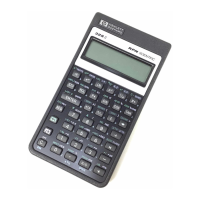13–2 Programming Techniques
File name 32sii-Manual-E-0424
Printed Date : 2003/4/24 Size : 17.7 x 25.2 cm
A routine typically starts with a label (LBL) and ends with an instruction that
alters or stops program execution, such as RTN, GTO, or STOP, or perhaps
another label.
Calling Subroutines (XEQ, RTN)
A subroutine is a routine that is called from (executed by) another routine and
returns to that same routine when the subroutine is finished. The subroutine
must start with a LBL and end with a RTN. A subroutine is itself a routine, and
it can call other subroutines.
XEQ must branch to a label (LBL) for the subroutine. (It cannot branch to a
line number.)
At the very next RTN encountered, program execution returns to the line
after the originating XBQ.
For example, routine Q in the "Normal and Inverse–Normal Distributions"
program in chapter 16 is a subroutine (to calculate Q(x)) that is called from
routine D by line
%
. Routine Q ends with a RTN instruction that
sends program execution back to routine D (to store and display the result) at
line D04. See the flow diagrams below.
The flow diagrams in this chapter use this notation:
!
1
Program execution branches from this line to
the line marked
1
("from 1").
1
Program execution branches from a line
marked
1
("to 1") to this line.

